Abstract
1. Protein kinase C (PKC) stimulators, 12-O-tetradecanoyl-phorbol-13-acetate (TPA) or cis-unsaturated fatty acid (UFA), have been shown to prolong synaptic enhancement induced by long-term potentiation (LTP). This observation suggests a role for PKC in the biochemical mechanisms underlying maintained enhancement. 2. To determine if PKC stimulators prolong LTP by acting selectively at synapses given high-frequency stimulation or by actions that are not synapse-specific (e.g. increased postsynaptic excitability) we examined the effect of TPA or UFA on input-selective enhancement. Population EPSPs, evoked in the same granule cell population by either the medial (MPP) or lateral (LPP) perforant path, can be selectively enhanced leaving the other perforant path input which receives only low-frequency stimulation as an internal control for PKC stimulator effects not specific to enhanced synapses. 3. Synapse-specific effects were in fact observed, as UFA or TPA selectively prolonged MPP enhancement following two trains of high-frequency MPP stimulation, without affecting responses evoked by the LPP. A similar synapse selectivity of PKC stimulator action was seen following high-frequency LPP stimulation. 4. These findings suggest that PKC stimulators prolong enhancement by acting specifically at high-frequency-stimulated synapses. PKC stimulators do not appear to affect either postsynaptic neurone excitability or synapses given only low-frequency stimulation. This provides further evidence that PKC acts synergistically with the consequences of repetitive synaptic activation to maintain enhancement.
Full text
PDF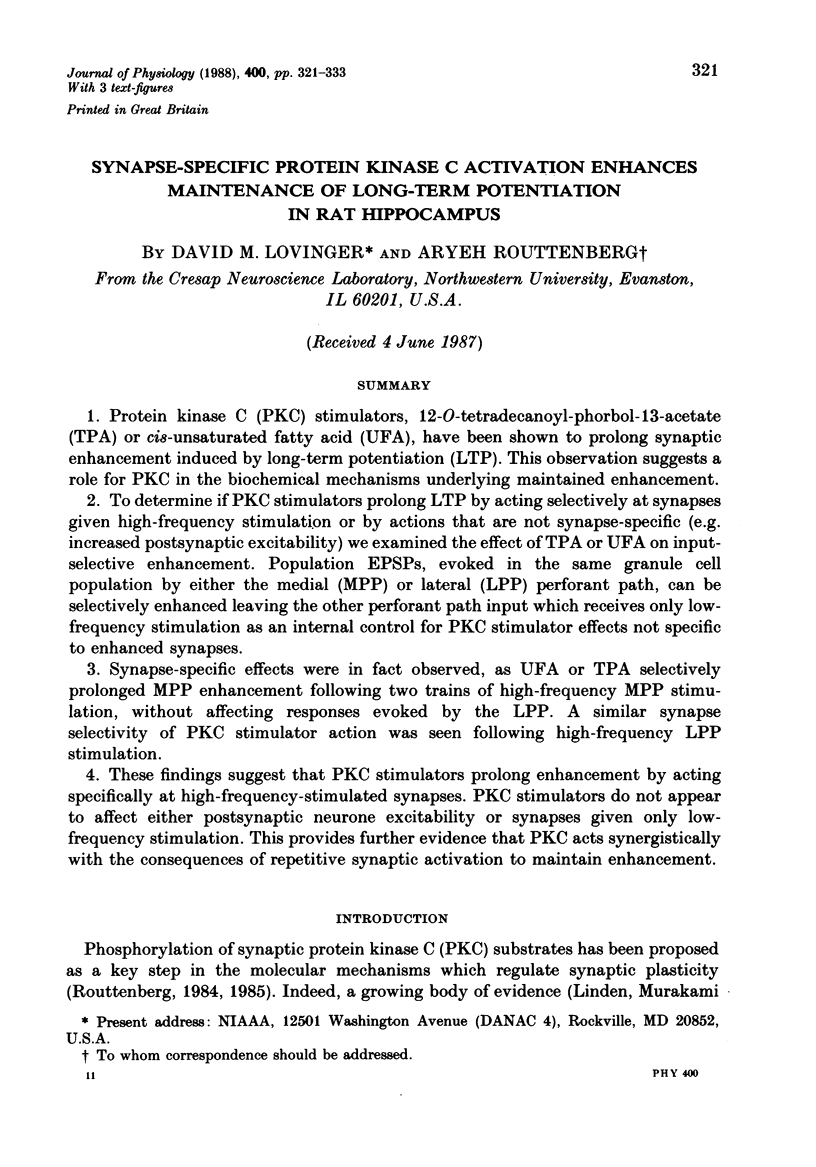
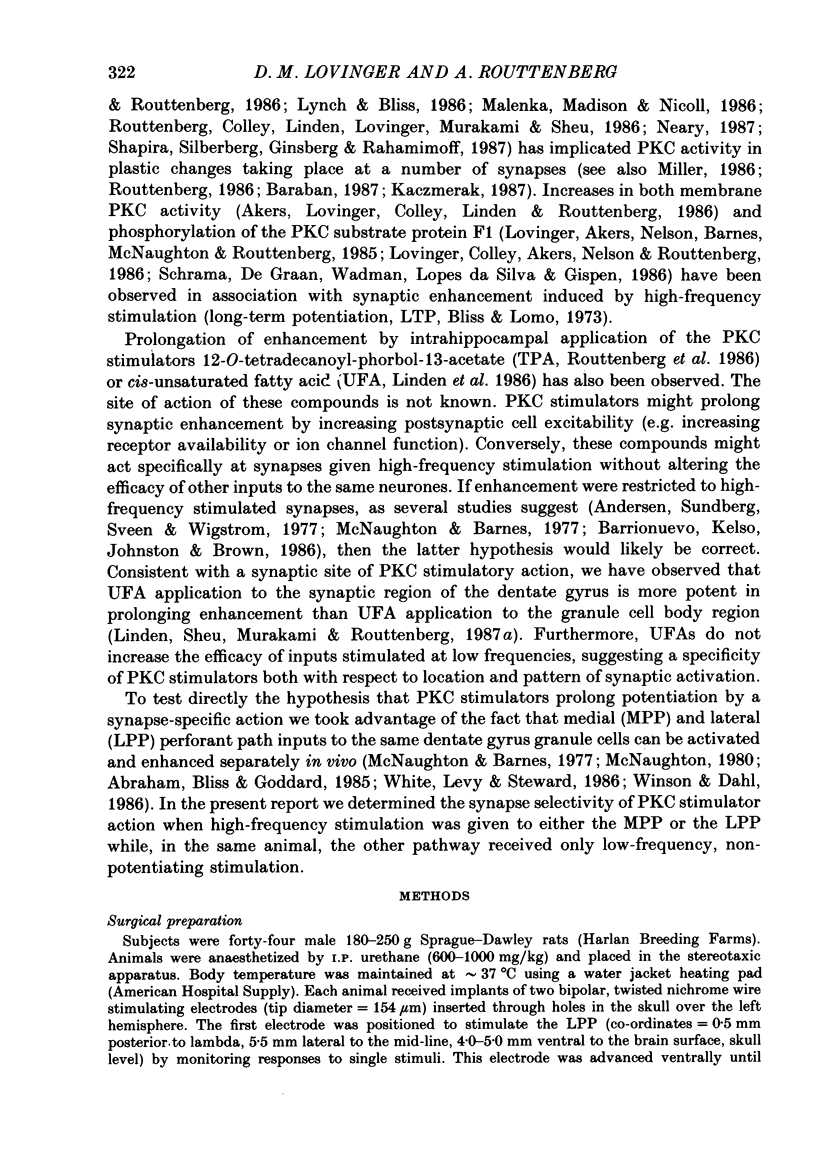
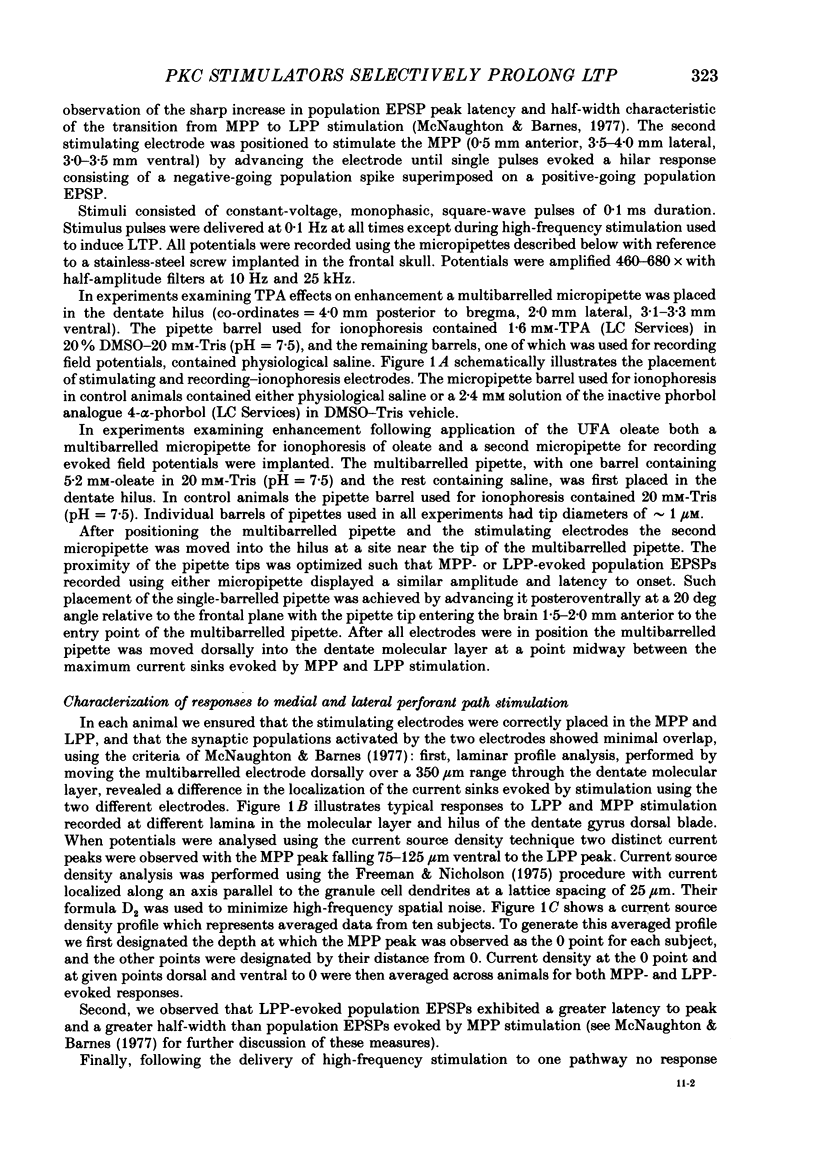
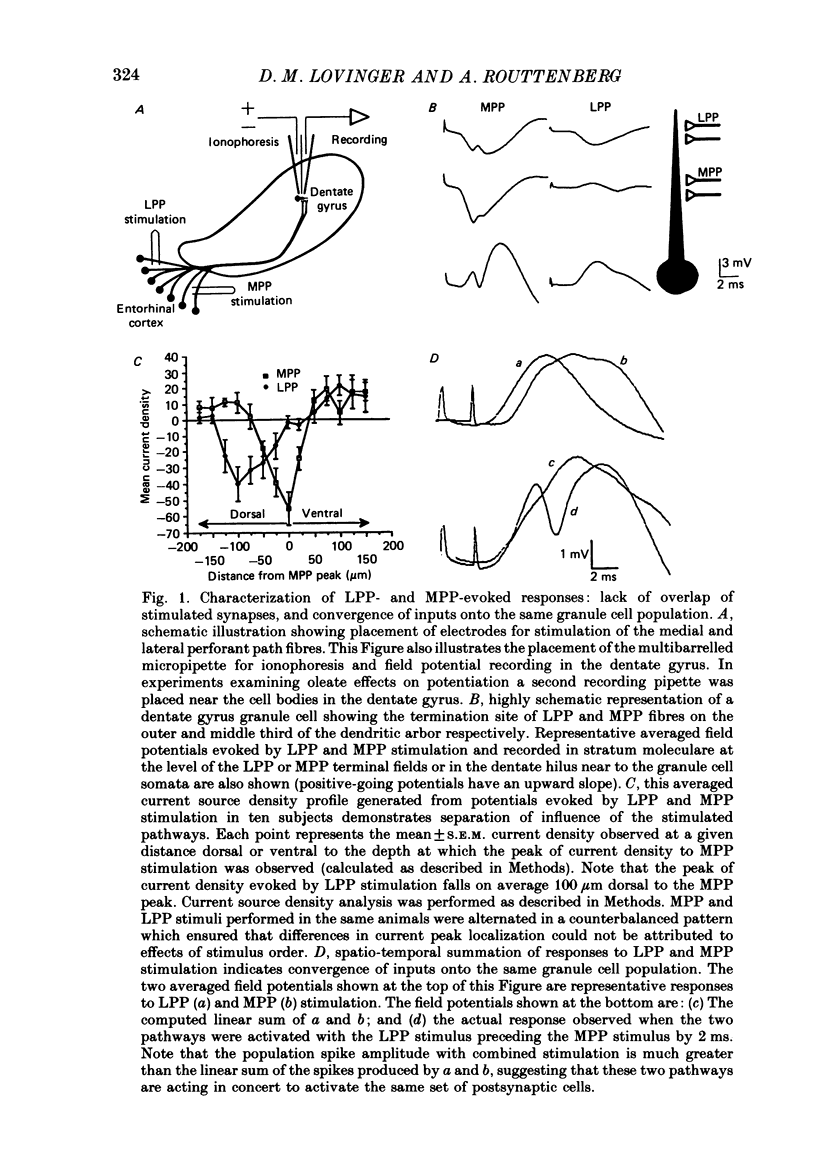
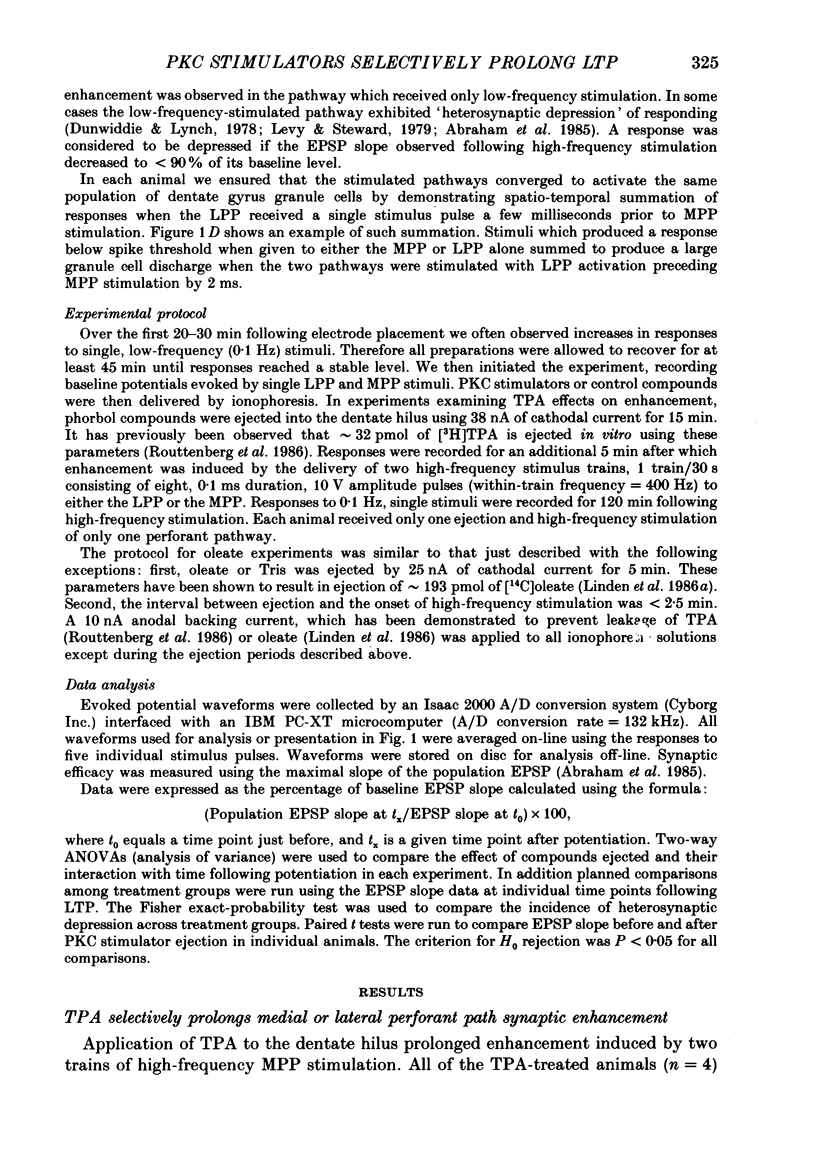
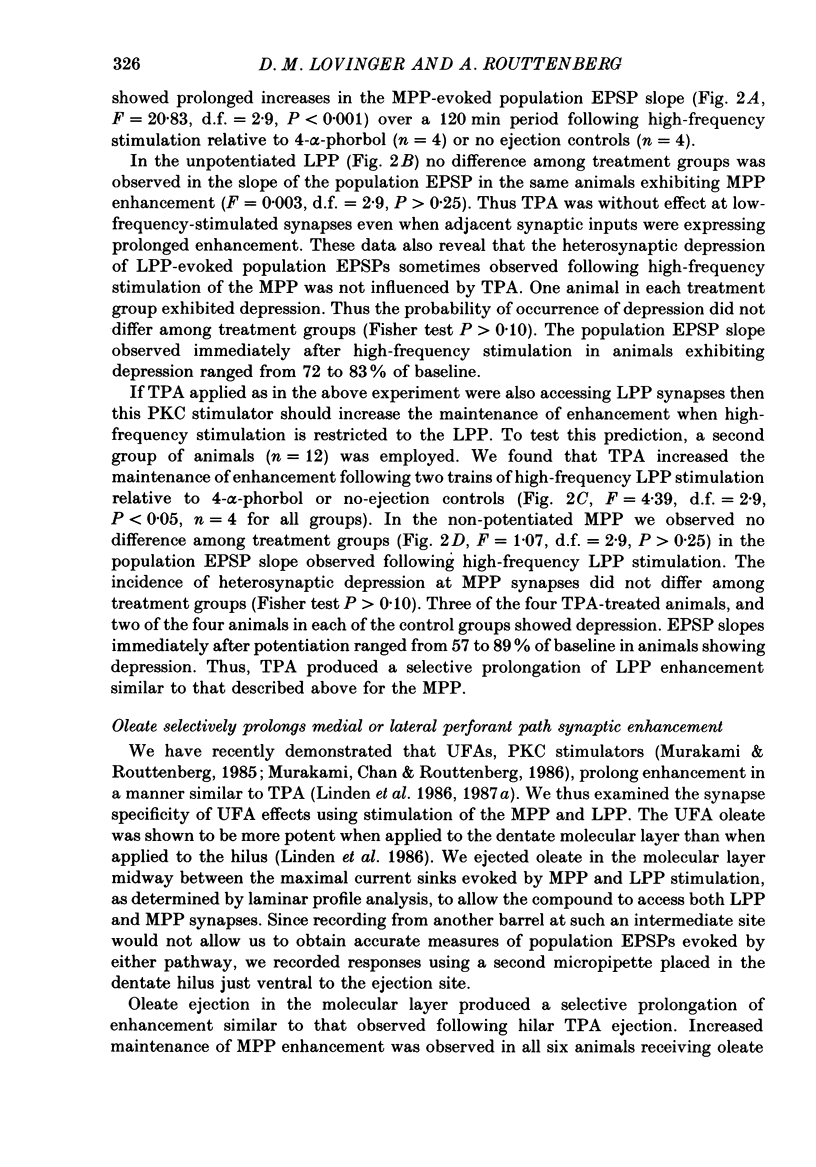
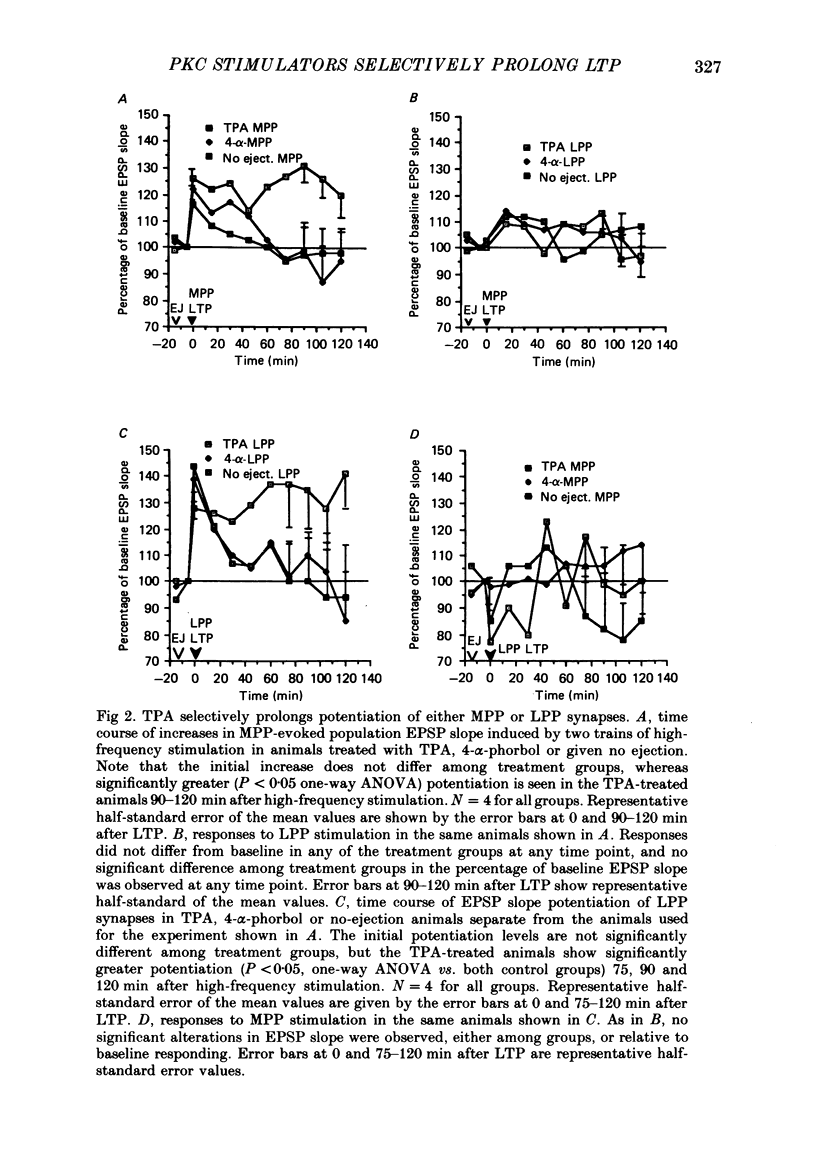
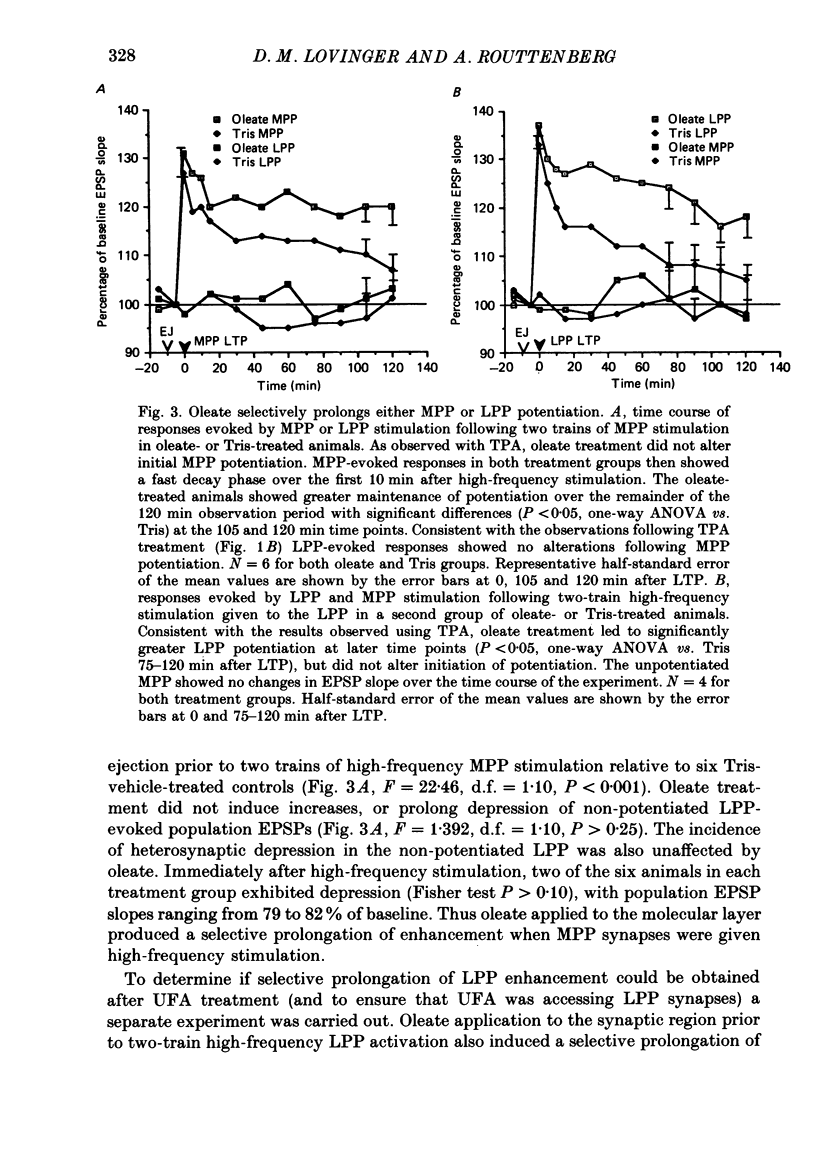
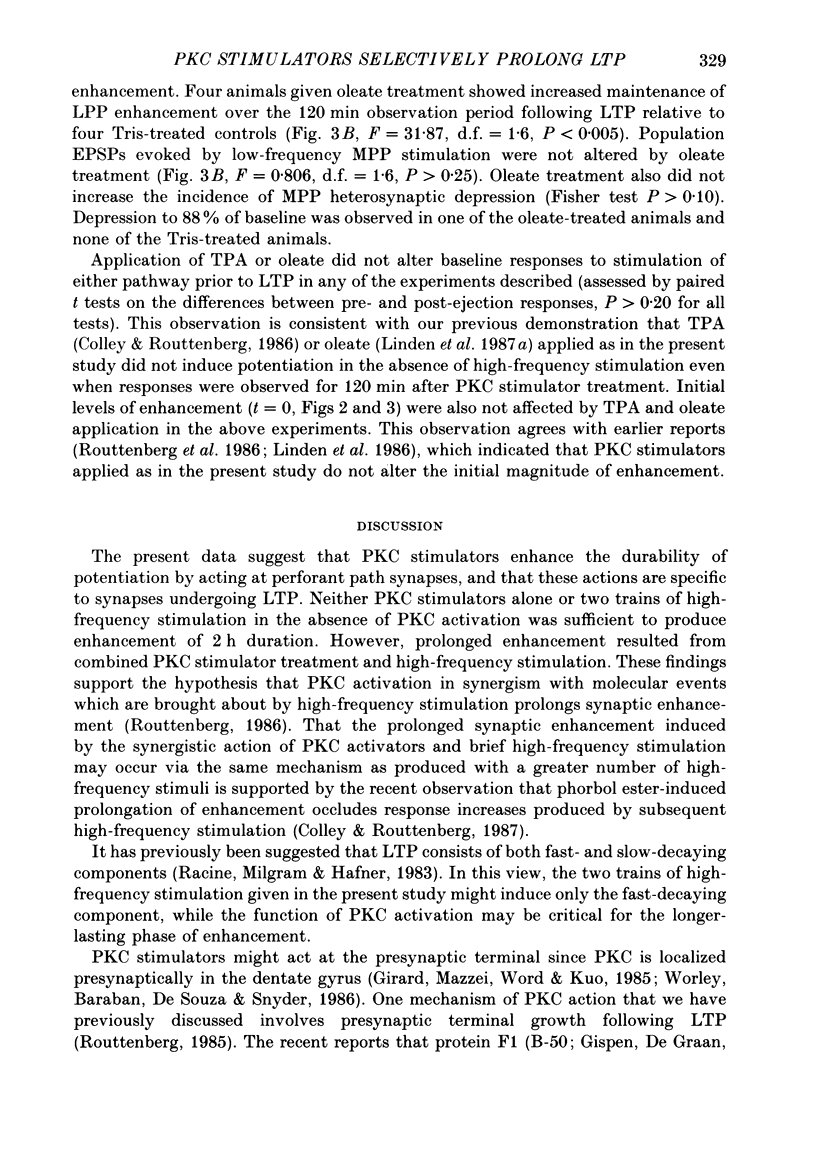
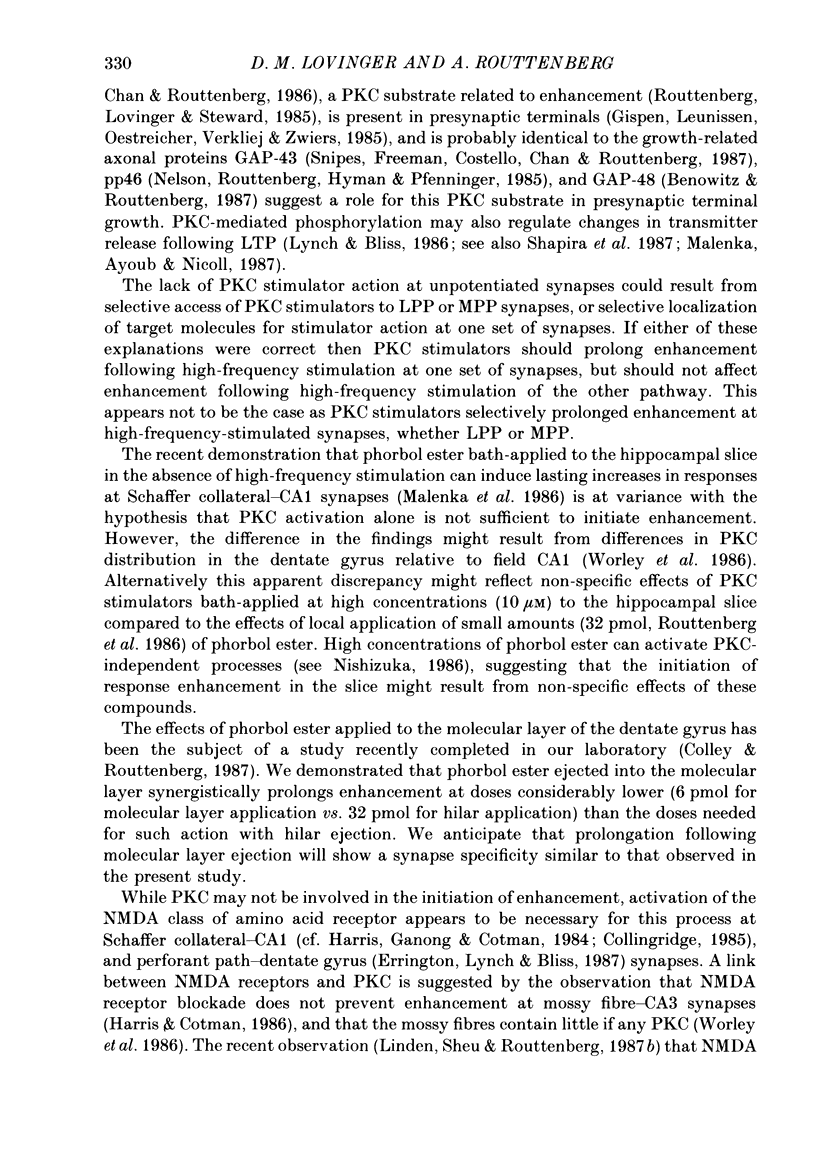
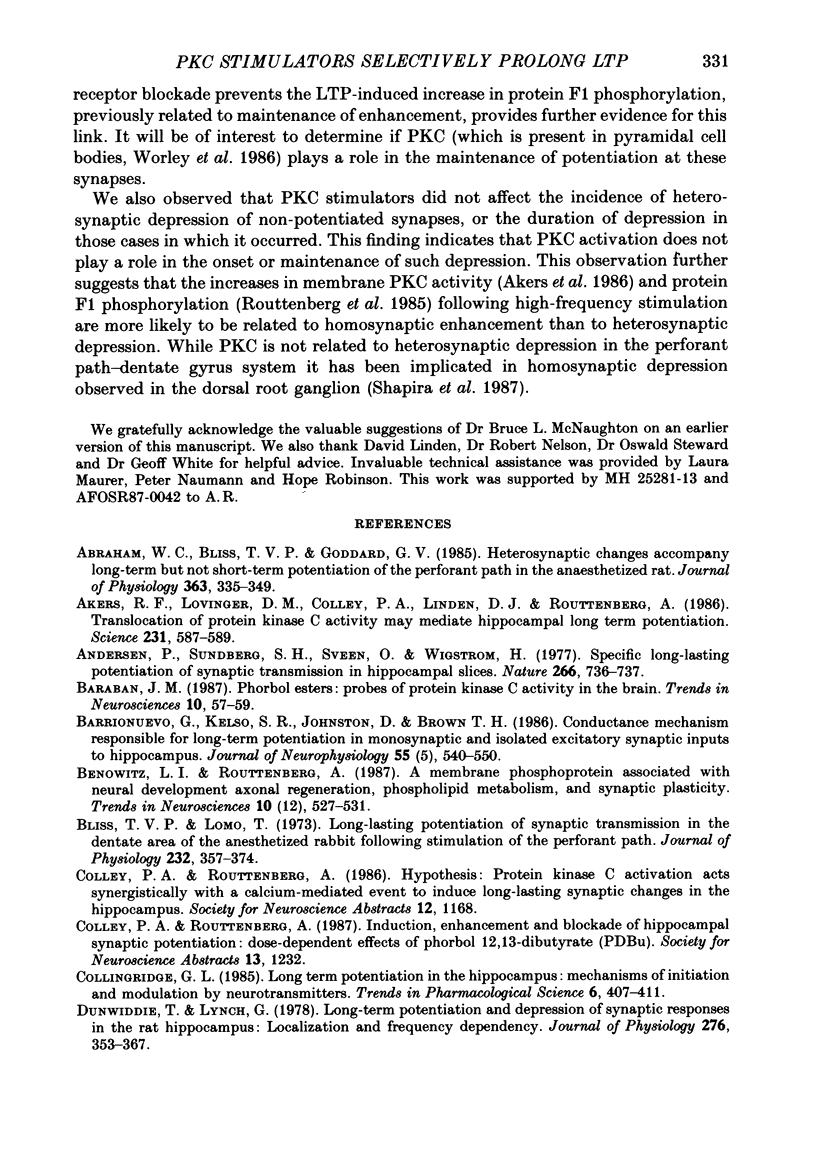
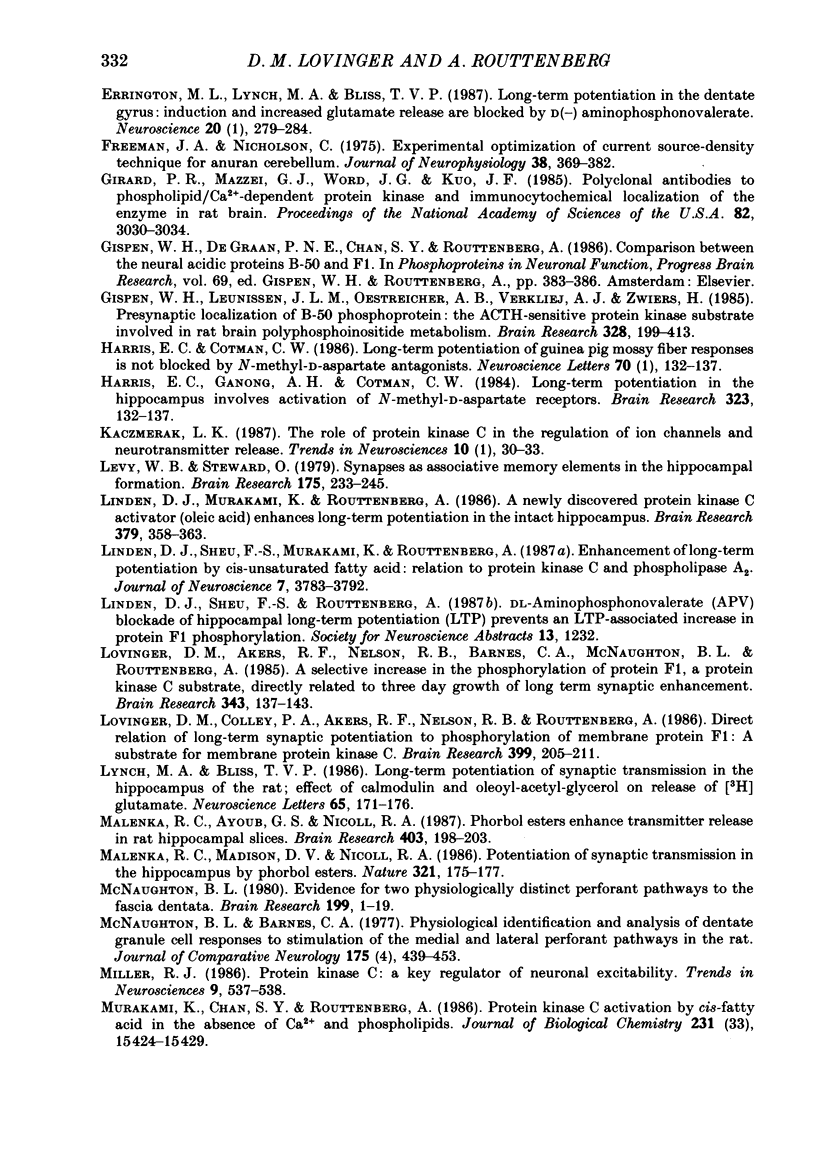
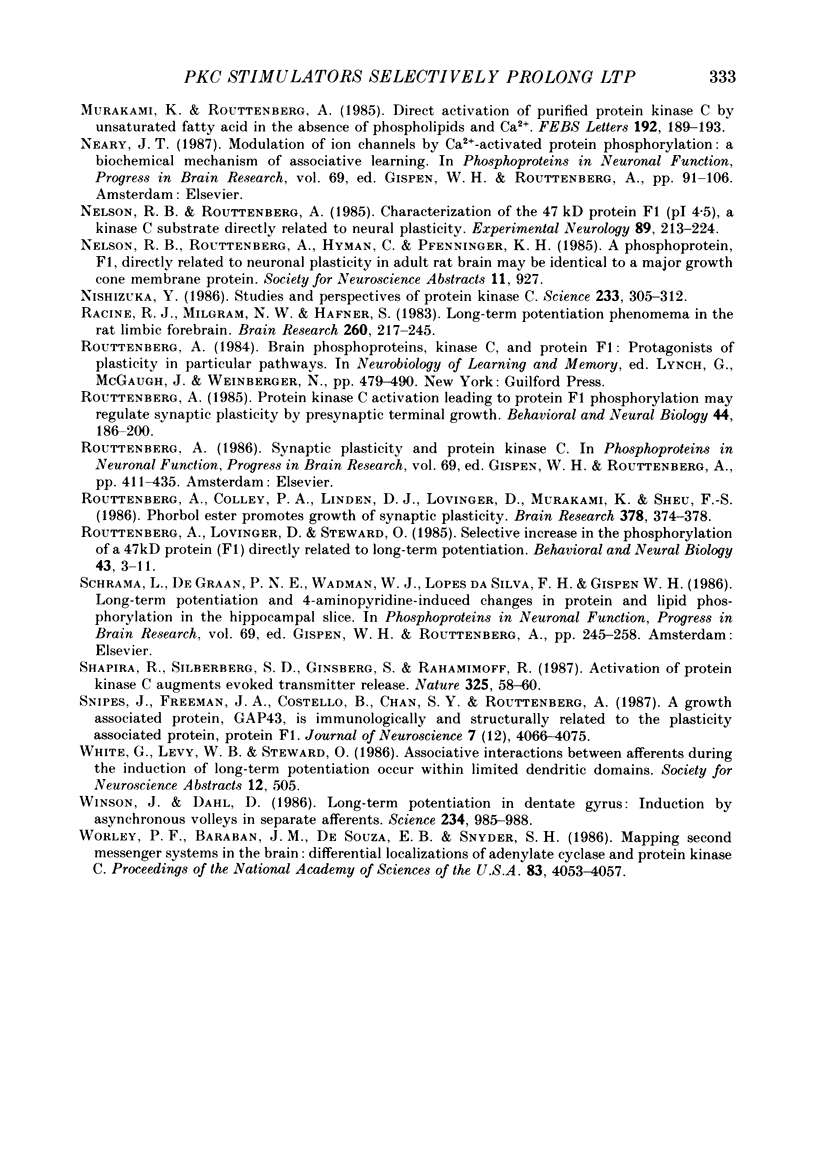
Selected References
These references are in PubMed. This may not be the complete list of references from this article.
- Abraham W. C., Bliss T. V., Goddard G. V. Heterosynaptic changes accompany long-term but not short-term potentiation of the perforant path in the anaesthetized rat. J Physiol. 1985 Jun;363:335–349. doi: 10.1113/jphysiol.1985.sp015714. [DOI] [PMC free article] [PubMed] [Google Scholar]
- Akers R. F., Lovinger D. M., Colley P. A., Linden D. J., Routtenberg A. Translocation of protein kinase C activity may mediate hippocampal long-term potentiation. Science. 1986 Feb 7;231(4738):587–589. doi: 10.1126/science.3003904. [DOI] [PubMed] [Google Scholar]
- Andersen P., Sundberg S. H., Sveen O., Wigström H. Specific long-lasting potentiation of synaptic transmission in hippocampal slices. Nature. 1977 Apr 21;266(5604):736–737. doi: 10.1038/266736a0. [DOI] [PubMed] [Google Scholar]
- Barrionuevo G., Kelso S. R., Johnston D., Brown T. H. Conductance mechanism responsible for long-term potentiation in monosynaptic and isolated excitatory synaptic inputs to hippocampus. J Neurophysiol. 1986 Mar;55(3):540–550. doi: 10.1152/jn.1986.55.3.540. [DOI] [PubMed] [Google Scholar]
- Bliss T. V., Gardner-Medwin A. R. Long-lasting potentiation of synaptic transmission in the dentate area of the unanaestetized rabbit following stimulation of the perforant path. J Physiol. 1973 Jul;232(2):357–374. doi: 10.1113/jphysiol.1973.sp010274. [DOI] [PMC free article] [PubMed] [Google Scholar]
- Dunwiddie T., Lynch G. Long-term potentiation and depression of synaptic responses in the rat hippocampus: localization and frequency dependency. J Physiol. 1978 Mar;276:353–367. doi: 10.1113/jphysiol.1978.sp012239. [DOI] [PMC free article] [PubMed] [Google Scholar]
- Errington M. L., Lynch M. A., Bliss T. V. Long-term potentiation in the dentate gyrus: induction and increased glutamate release are blocked by D(-)aminophosphonovalerate. Neuroscience. 1987 Jan;20(1):279–284. doi: 10.1016/0306-4522(87)90019-4. [DOI] [PubMed] [Google Scholar]
- Freeman J. A., Nicholson C. Experimental optimization of current source-density technique for anuran cerebellum. J Neurophysiol. 1975 Mar;38(2):369–382. doi: 10.1152/jn.1975.38.2.369. [DOI] [PubMed] [Google Scholar]
- Girard P. R., Mazzei G. J., Wood J. G., Kuo J. F. Polyclonal antibodies to phospholipid/Ca2+-dependent protein kinase and immunocytochemical localization of the enzyme in rat brain. Proc Natl Acad Sci U S A. 1985 May;82(9):3030–3034. doi: 10.1073/pnas.82.9.3030. [DOI] [PMC free article] [PubMed] [Google Scholar]
- Gispen W. H., De Graan P. N., Chan S. Y., Routtenberg A. Comparison between the neural acidic proteins B-50 and F1. Prog Brain Res. 1986;69:383–386. doi: 10.1016/s0079-6123(08)61072-9. [DOI] [PubMed] [Google Scholar]
- Harris E. W., Cotman C. W. Long-term potentiation of guinea pig mossy fiber responses is not blocked by N-methyl D-aspartate antagonists. Neurosci Lett. 1986 Sep 25;70(1):132–137. doi: 10.1016/0304-3940(86)90451-9. [DOI] [PubMed] [Google Scholar]
- Harris E. W., Ganong A. H., Cotman C. W. Long-term potentiation in the hippocampus involves activation of N-methyl-D-aspartate receptors. Brain Res. 1984 Dec 3;323(1):132–137. doi: 10.1016/0006-8993(84)90275-0. [DOI] [PubMed] [Google Scholar]
- Levy W. B., Steward O. Synapses as associative memory elements in the hippocampal formation. Brain Res. 1979 Oct 19;175(2):233–245. doi: 10.1016/0006-8993(79)91003-5. [DOI] [PubMed] [Google Scholar]
- Linden D. J., Murakami K., Routtenberg A. A newly discovered protein kinase C activator (oleic acid) enhances long-term potentiation in the intact hippocampus. Brain Res. 1986 Aug 6;379(2):358–363. doi: 10.1016/0006-8993(86)90790-0. [DOI] [PubMed] [Google Scholar]
- Linden D. J., Sheu F. S., Murakami K., Routtenberg A. Enhancement of long-term potentiation by cis-unsaturated fatty acid: relation to protein kinase C and phospholipase A2. J Neurosci. 1987 Nov;7(11):3783–3792. doi: 10.1523/JNEUROSCI.07-11-03783.1987. [DOI] [PMC free article] [PubMed] [Google Scholar]
- Lovinger D. M., Akers R. F., Nelson R. B., Barnes C. A., McNaughton B. L., Routtenberg A. A selective increase in phosporylation of protein F1, a protein kinase C substrate, directly related to three day growth of long term synaptic enhancement. Brain Res. 1985 Sep 16;343(1):137–143. doi: 10.1016/0006-8993(85)91167-9. [DOI] [PubMed] [Google Scholar]
- Lovinger D. M., Colley P. A., Akers R. F., Nelson R. B., Routtenberg A. Direct relation of long-term synaptic potentiation to phosphorylation of membrane protein F1, a substrate for membrane protein kinase C. Brain Res. 1986 Dec 10;399(2):205–211. doi: 10.1016/0006-8993(86)91510-6. [DOI] [PubMed] [Google Scholar]
- Lynch M. A., Bliss T. V. Long-term potentiation of synaptic transmission in the hippocampus of the rat; effect of calmodulin and oleoyl-acetyl-glycerol on release of [3H]glutamate. Neurosci Lett. 1986 Apr 11;65(2):171–176. doi: 10.1016/0304-3940(86)90299-5. [DOI] [PubMed] [Google Scholar]
- Malenka R. C., Ayoub G. S., Nicoll R. A. Phorbol esters enhance transmitter release in rat hippocampal slices. Brain Res. 1987 Feb 10;403(1):198–203. doi: 10.1016/0006-8993(87)90145-4. [DOI] [PubMed] [Google Scholar]
- Malenka R. C., Madison D. V., Nicoll R. A. Potentiation of synaptic transmission in the hippocampus by phorbol esters. Nature. 1986 May 8;321(6066):175–177. doi: 10.1038/321175a0. [DOI] [PubMed] [Google Scholar]
- McNaughton B. L., Barnes C. A. Physiological identification and analysis of dentate granule cell responses to stimulation of the medial and lateral perforant pathways in the rat. J Comp Neurol. 1977 Oct 15;175(4):439–454. doi: 10.1002/cne.901750404. [DOI] [PubMed] [Google Scholar]
- McNaughton B. L. Evidence for two physiologically distinct perforant pathways to the fascia dentata. Brain Res. 1980 Oct 13;199(1):1–19. doi: 10.1016/0006-8993(80)90226-7. [DOI] [PubMed] [Google Scholar]
- Murakami K., Chan S. Y., Routtenberg A. Protein kinase C activation by cis-fatty acid in the absence of Ca2+ and phospholipids. J Biol Chem. 1986 Nov 25;261(33):15424–15429. [PubMed] [Google Scholar]
- Murakami K., Routtenberg A. Direct activation of purified protein kinase C by unsaturated fatty acids (oleate and arachidonate) in the absence of phospholipids and Ca2+. FEBS Lett. 1985 Nov 18;192(2):189–193. doi: 10.1016/0014-5793(85)80105-8. [DOI] [PubMed] [Google Scholar]
- Neary J. T. Modulation of ion channels by Ca2+-activated protein phosphorylation: a biochemical mechanism for associative learning. Prog Brain Res. 1986;69:91–106. doi: 10.1016/s0079-6123(08)61051-1. [DOI] [PubMed] [Google Scholar]
- Nelson R. B., Routtenberg A. Characterization of protein F1 (47 kDa, 4.5 pI): a kinase C substrate directly related to neural plasticity. Exp Neurol. 1985 Jul;89(1):213–224. doi: 10.1016/0014-4886(85)90277-8. [DOI] [PubMed] [Google Scholar]
- Nishizuka Y. Studies and perspectives of protein kinase C. Science. 1986 Jul 18;233(4761):305–312. doi: 10.1126/science.3014651. [DOI] [PubMed] [Google Scholar]
- Racine R. J., Milgram N. W., Hafner S. Long-term potentiation phenomena in the rat limbic forebrain. Brain Res. 1983 Feb 7;260(2):217–231. doi: 10.1016/0006-8993(83)90676-5. [DOI] [PubMed] [Google Scholar]
- Routtenberg A., Colley P., Linden D., Lovinger D., Murakami K., Sheu F. S. Phorbol ester promotes growth of synaptic plasticity. Brain Res. 1986 Jul 23;378(2):374–378. doi: 10.1016/0006-8993(86)90940-6. [DOI] [PubMed] [Google Scholar]
- Routtenberg A., Lovinger D. M. Selective increase in phosphorylation of a 47-kDa protein (F1) directly related to long-term potentiation. Behav Neural Biol. 1985 Jan;43(1):3–11. doi: 10.1016/s0163-1047(85)91426-8. [DOI] [PubMed] [Google Scholar]
- Routtenberg A. Protein kinase C activation leading to protein F1 phosphorylation may regulate synaptic plasticity by presynaptic terminal growth. Behav Neural Biol. 1985 Sep;44(2):186–200. doi: 10.1016/s0163-1047(85)90184-0. [DOI] [PubMed] [Google Scholar]
- Schrama L. H., De Graan P. N., Wadman W. J., Lopes da Silva F. H., Gispen W. H. Long-term potentiation and 4-aminopyridine-induced changes in protein and lipid phosphorylation in the hippocampal slice. Prog Brain Res. 1986;69:245–257. doi: 10.1016/s0079-6123(08)61063-8. [DOI] [PubMed] [Google Scholar]
- Shapira R., Silberberg S. D., Ginsburg S., Rahamimoff R. Activation of protein kinase C augments evoked transmitter release. Nature. 1987 Jan 1;325(6099):58–60. doi: 10.1038/325058a0. [DOI] [PubMed] [Google Scholar]
- Snipes G. J., Chan S. Y., McGuire C. B., Costello B. R., Norden J. J., Freeman J. A., Routtenberg A. Evidence for the coidentification of GAP-43, a growth-associated protein, and F1, a plasticity-associated protein. J Neurosci. 1987 Dec;7(12):4066–4075. doi: 10.1523/JNEUROSCI.07-12-04066.1987. [DOI] [PMC free article] [PubMed] [Google Scholar]
- Winson J., Dahl D. Long-term potentiation in dentate gyrus: induction by asynchronous volleys in separate afferents. Science. 1986 Nov 21;234(4779):985–988. doi: 10.1126/science.3775372. [DOI] [PubMed] [Google Scholar]
- Worley P. F., Baraban J. M., De Souza E. B., Snyder S. H. Mapping second messenger systems in the brain: differential localizations of adenylate cyclase and protein kinase C. Proc Natl Acad Sci U S A. 1986 Jun;83(11):4053–4057. doi: 10.1073/pnas.83.11.4053. [DOI] [PMC free article] [PubMed] [Google Scholar]


